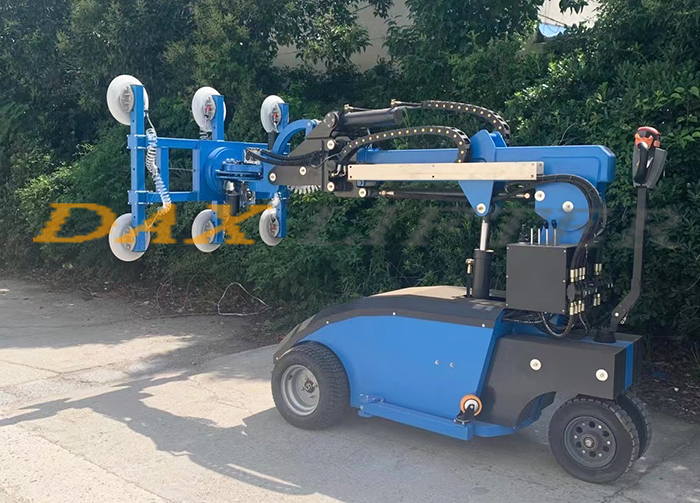Smart Vacuum Lift Equipment
Smart vacuum lift equipment is mainly composed of vacuum pump, suction cup, control system, etc. Its working principle is to use a vacuum pump to generate negative pressure to form a seal between the suction cup and the glass surface, thereby adsorbing the glass on the suction cup. When the electric vacuum lifter moves, the glass moves with it. Our robot vacuum lifter is very suitable for transportation and installation work. Its working height can reach 3.5m. If necessary, the maximum working height can reach 5m, which can well help users to complete the work of high-altitude installation. And it can be customized with electric rotation and electric rollover, so that even when working at high altitude, the glass can be easily turned by controlling the handle. However, it should be noted that the robot vacuum glass suction cup is more suitable for glass installation with a weight of 100-300kg. If the weight is larger, you can consider using a loader and a forklift suction cup together.
Technical Data
|
Model |
DXGL-LD 300 |
DXGL-LD 400 |
DXGL-LD 500 |
DXGL-LD 600 |
DXGL-LD 800 |
|
Capacity(kg) |
300 |
400 |
500 |
600 |
800 |
|
Manual rotation |
360° |
||||
|
Max lifting height(mm) |
3500 |
3500 |
3500 |
3500 |
5000 |
|
Operation method |
walking style |
||||
|
Battery(V/A) |
2*12/100 |
2*12/120 |
|||
|
Charger(V/A) |
24/12 |
24/15 |
24/15 |
24/15 |
24/18 |
|
walk motor(V/W) |
24/1200 |
24/1200 |
24/1500 |
24/1500 |
24/1500 |
|
Lift motor(V/W) |
24/2000 |
24/2000 |
24/2200 |
24/2200 |
24/2200 |
|
Width(mm) |
840 |
840 |
840 |
840 |
840 |
|
Length(mm) |
2560 |
2560 |
2660 |
2660 |
2800 |
|
Front wheel size/quantity(mm) |
400*80/1 |
400*80/1 |
400*90/1 |
400*90/1 |
400*90/2 |
|
Rear wheel size/quantity(mm) |
250*80 |
250*80 |
300*100 |
300*100 |
300*100 |
|
Suction cup size/quantity(mm) |
300 / 4 |
300 / 4 |
300 / 6 |
300 / 6 |
300 / 8 |
How does the vacuum glass suction cup work?
The working principle of the vacuum glass suction cup is mainly based on the atmospheric pressure principle and vacuum technology. When the suction cup is in close contact with the glass surface, the air in the suction cup is extracted through some means (such as using a vacuum pump), thereby forming a vacuum state inside the suction cup. Since the air pressure inside the suction cup is lower than the external atmospheric pressure, the external atmospheric pressure will generate an inward pressure, making the suction cup firmly adhere to the glass surface.
Specifically, when the suction cup comes into contact with the glass surface, the air inside the suction cup is pulled out, creating a vacuum. Since there is no air inside the suction cup, there is no atmospheric pressure. The atmospheric pressure outside the suction cup is greater than that inside the suction cup, so the external atmospheric pressure will produce an inward force on the suction cup. This force makes the suction cup stick tightly to the glass surface.
In addition, the vacuum glass suction cup also utilizes the principle of fluid mechanics. Before the vacuum suction cup adsorbs, the atmospheric pressure on the front and back sides of the object is the same, both at 1 bar normal pressure, and the atmospheric pressure difference is 0. This is a normal state. After the vacuum suction cup is adsorbed, the atmospheric pressure on the surface of the object's vacuum suction cup changes due to the evacuation effect of the vacuum suction cup, for example, it is reduced to 0.2 bar; while the atmospheric pressure in the corresponding area on the other side of the object remains unchanged and is still 1 bar normal pressure. In this way, there is a difference of 0.8 bar in the atmospheric pressure on the front and back sides of the object. This difference multiplied by the effective area covered by the suction cup is the vacuum suction power. This suction force allows the suction cup to adhere more firmly to the glass surface, maintaining a stable adsorption effect even during movement or operation.













